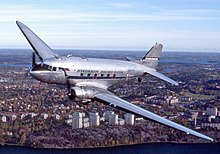1946 Australian National Airways DC-3 crash

Douglas DC-3 similar to VH-AET
|
|
| Accident summary | |
|---|---|
| Date | 10 March 1946 |
| Summary | Crash into sea |
| Site | South of Cambridge Aerodrome, Hobart, Tasmania 42°52′S 147°31′E / 42.86°S 147.52°ECoordinates: 42°52′S 147°31′E / 42.86°S 147.52°E |
| Passengers | 21 |
| Crew | 4 |
| Fatalities | All (25) |
| Survivors | 0 |
| Aircraft type | Douglas DC-3 |
| Registration | VH-AET |
| Flight origin | Hobart, Tasmania |
| Destination | Melbourne |
|
|
On Sunday 10 March 1946 a Douglas DC-3 aircraft departed from Hobart, Tasmania for a flight to Melbourne. The aircraft crashed into the sea with both engines operating less than 2 minutes after takeoff. All twenty-five people on board the aircraft died. It was Australia's worst civil aviation accident.
An investigation panel was promptly established to investigate the accident. The panel was unable to conclusively establish the cause but it decided the most likely cause was that the automatic pilot was inadvertently engaged shortly after takeoff while the gyroscope was caged. The Department of Civil Aviation took action to ensure that operation of the automatic pilot on-off control on Douglas DC-3 aircraft was made distinctive from operation of any other control in the cockpit, and that instructions were issued impressing on pilots that gyroscopes should be un-caged prior to takeoff.
An inquiry chaired by a Supreme Court judge closely examined three different theories but found there was insufficient evidence to determine any one of them as the cause. This inquiry discovered that the captain of the aircraft was diabetic and had kept it secret from both his employer and the Department of Civil Aviation. The judge considered the captain's diabetes and self-administration of insulin probably contributed significantly to the accident but he stopped short of making this his official conclusion.
In his report, the judge recommended modification of the lever actuating the automatic pilot. The inquiry uncovered four irregularities in the regulation of civil aviation in Australia and the judge made four recommendations to deal with these irregularities.
The Australian National Airways aircraft registered VH-AET arrived at Cambridge aerodrome at 8:15 pm local time, about four hours late. The return flight to Essendon Airport was scheduled to depart at 4:50 pm, but did not do so until 8:50 pm.
...
Wikipedia
